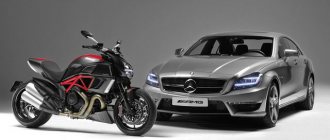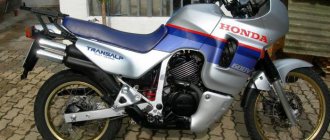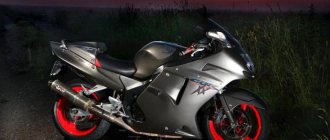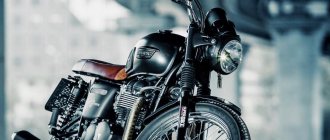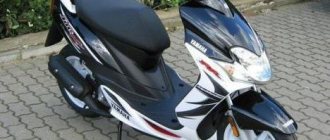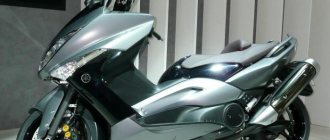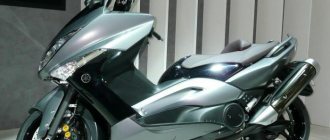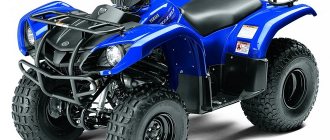The Yamaha FZX 750 motorcycle managed to make a lot of noise in its time. Its angular appearance, unusual even for an old-school bike, made it recognizable and unique in its own way, but did not at all become the main feature of this bike. It was immediately appreciated by those who are not averse to driving. To put it bluntly, outwardly he does not at all look like a highway conqueror capable of treating his opponents left behind to dust. Nevertheless, the Yamaha FZX 750 is a true king of the road.
A short historical excursion
The model was produced in 1985-1994. It was built on the basis of the engine from the Yamaha FZ750. The manufacturer derated it, which made it possible to increase torque at low speeds. The main feature of this engine is 5 valves on each cylinder. Initially, it was assumed that the Yamaha FZX 750 will remain domestically. But later they began to produce models for the US market, in the name of which the name Fazer appeared. The American version had a 50 cc larger engine. But in terms of technical characteristics, it was slightly inferior to the “Japanese”. A classic dragster that combined the features of a road racer and a sport, the Yamaha FZX 750 later became the prototype of the legendary successor - the Yamaha V-max 1200 motorcycle.
Uniqueness is the secret to the success of the Yamaha FZX 750 Fazer
In those glorious times, when motorcycles were created by engineers, not marketers, many remarkable models were produced. One of them is the Yamaha FZX 750, the younger brother of the famous V-Max.
Once upon a time, the Japanese shocked the whole world by presenting to the public one of the most famous motorcycle models in the world - the Yamaha V-Max 1200. This monster was a brutally powerful motor, around which the bike itself was somehow built, and was frightening with its unbridled power. even experienced motorcyclists. Then the designers thought about it and decided to offer the public about the same thing, but easier and a little calmer. This is how the Yamaha FZX 750 Fazer was born. It has nothing to do with the modern Fazer series of road bikes - the first generation of Fazers was more of a dragster than a classic bike. At the same time, the Yamaha FZX 750's technical characteristics were such that it easily overtook most sportbikes of those years. And even with modern plastic rockets, this veteran can still show where the biker’s adrenaline comes from.
Behavior
Looks can be deceiving, and even more so in the case of the FZX 750. Its character on the road can drive an inexperienced pilot to gray hair. This is a real hooligan and rebel. “A wolf in sheep’s clothing,” the owners joke about him, without lying at all. Beneath its unassuming exterior beats the heart of a sportbike. His profile is high speed, racing and long roads.
“They don’t make things like this now,” sigh sadly the old bikers who were lucky enough to own motorcycles from this series at one time. Indeed, among modern bikes, the Yamaha FZX 750 motorcycle has no analogues. It's not that he was ahead of his time or the best dragster in the world. But its uniqueness is undeniable. That’s why true connoisseurs take good care of their iron horses, which are no longer new and have traveled many kilometers. And with careful maintenance and skillful handling, this motorcycle can become a real long-liver - its endurance resource is very large. In addition, Yamaha spare parts are available almost everywhere today.
Advantages
In general, the Yamaha Zeal 250 is a rather interesting motorcycle that can still compete with modern analogues.
- Inexpensive spare parts.
- Smooth ride.
- Uncomplicated design of components and assemblies.
- A simple manual that allows you to repair a motorcycle for owners who are encountering motorcycle repair for the first time.
- Moderate fuel consumption.
and disadvantages
- Low motor life.
- The engine is “strangled” and has been deprived of a variable exhaust geometry system, which is why the engine’s potential is revealed only at high speeds.
- It is difficult to find a motorcycle in good condition on the secondary market of the CIS.
If you intend to carry out external and technical tuning of the motorcycle, then, unfortunately, you will not even find Chinese components for it, due to its low popularity among competitors.
Characteristics
The motorcycle has the following technical features:
| Model | Yamaha FZX 750 (Fazer) |
| Year of issue | 1985-1994 |
| Number of cylinders | 4 |
| Volume | 749 cc cm |
| Ignition | electronic |
| Number of valves per cylinder | 5 |
| Fuel supply | carburetor |
| Power (hp) | 94 |
| checkpoint | 6-speed |
| Drive unit | chain |
| Frame | duplex, steel |
| Maximum speed (km/h) | 220 |
| Acceleration to hundreds (sec.) | 4 |
| Fuel tank capacity (liters) | 13 |
| Motorcycle weight without gasoline (kg) | 204 |
Thanks to this table you can get a complete picture of the motorcycle.
External changes
The next step was to convert the front suspension from a 2005 Yamaha R6, upgraded with Traxxion Dynamics AK-20 cartridges. An Öhlins steering damper helps control the 200 horsepower bike.
The front fairing is model F1FU from the Airtech Streamlining offering. Of course, highly modified, because how could it be otherwise in such a complex project. The single headlight consists of a JW Speaker LED and is offset to the right, just like the XJ750R racer.
The fuel tank is a transplant from a Yamaha XS750 with Racefit filler added to it.
The rear fairing is a special solution with Alcantara seat upholstery and black leather.
The bike's paint job was done by Mike Lewis of Gary's Body Shop in Atlanta.
The exhaust system is a stainless steel structure with a titanium Akrapovič muffler. Also worth mentioning are the central display, track-specific switches, lightweight racks, clips and Racetec RR K2 tires from Metzeler. They allow you to maintain minimal grip when accelerating with this 200 horsepower savage.
The idea, execution, creativity and unique solutions are truly impressive. Undertaking a redesign of the thankless piece of equipment that is the XJ750 and creating such a design is an attack on the highest podium in the entire world of custom designs. Quite a successful attack!
Motorcycles where mechanical prowess goes hand in hand with aesthetic values are a rarity. Until now, the division was clear: they were looking for equipment and moving the equipment well. Derek Kimes put it all together on his first project, so I'm looking forward to the next one!
Post Views: 1
MotoNoob.ru
Features of power units
Initially, the motorcycle had a 6-speed transmission, and since 1990 it began to be produced with a 5-speed. When creating it, it was decided to depower the engine, which is why it lost a little in power, but gained in torque. This is felt especially well at low speeds. Acceleration to 100 km/h in less than 4 seconds is considered an excellent indicator even for sports class models. This allows the owner of the Yamaha FZX 750 motorcycle to get far ahead at the start. And its speed capabilities, up to 220 km/h, will ensure leadership along the entire route. The motorcycle has a moderate appetite - from 6 to 9 liters, depending on the conditions and riding style. According to some owners, this bike should have been equipped with a more impressive gas tank to make long range accessible.
Review of the Yamaha FZX 750 Fazer motorcycle
Yamaha FZX 750 road motorcycle model
appeared in 1986 on the domestic Japanese market as the “younger brother” of the Yamaha Vmax 1200. The motorcycle was aimed at the Japanese market, but was also officially supplied to European countries. For a limited time, the model was also available in the USA, but the engine capacity of the North American versions did not exceed 700 cm³ (this was due to the presence of customs restrictions on the import of motorcycles with a displacement of over 700 cm³).
Models outside the Japanese market were sold with the Fazer prefix - Yamaha FZX750 Fazer
. European models were visually distinguished by their red color (Apple Red), but the 1993 French versions were sold in a dark blue color (Dark Grayish Blue Metallic). Intra-Japanese modifications of the FZX750 were available only in gray (Orion Silver) - the first generation; and dark blue color (Dark Grayish Blue Metallic) – second generation. In the last year of production of the motorcycle in Japan, the model was painted black and silver (New Silver Dust). Also, export versions did not have a belt on the saddle and were additionally equipped with a handle for the passenger.
The main difference between the European versions and the Japanese ones is the engine power - the maximum declared power of the Yamaha FZX750 Fazer in Europe reached 96 hp, while in Japan this characteristic did not exceed 77 hp. (maximum speeds were lower, but the torque was fully available already at 6000 rpm, instead of 8000 rpm on full-power European versions). It should also be noted that not all European modifications of the Yamaha FZX750 Fazer were full-powered, but only with 1UF, 2AK, 3MU engines.
In 1990, the Yamaha FZX 750 model received serious technical changes that affected the engine (the power of the Japanese versions decreased to 74 hp) and the gearbox - the 6-speed gearbox was replaced by a 5-speed one. Note that the change in gearbox was due to the engineers’ desire to give the motorcycle more “road” features at the expense of dragster qualities. It is for this reason that full-powered European modifications with a 6-speed gearbox, which have shorter gears and, as a result, a more powerful start, were especially valued.
In 1998, the model received an update to the exhaust system to comply with new environmental standards and temporarily suspended production, resuming it only in 2000, by the end of which the motorcycle completely left the Yamaha production line. European modifications ceased production by 1998.
The main competitors of the Yamaha FZX750 Fazer in the class:
Brief history of the model
1986 – start of production and sales of Yamaha FZX 750.
Model
: Yamaha FZX750 (Japan).
Factory designation
: 2AK0.
1987 – no significant changes.
Model
: Yamaha FZX750 Fazer (Europe).
Factory designation
: 2JE, 2MU.
1988 – no significant changes.
Model
: Yamaha FZX750 Fazer (Europe).
Factory designation
: 2JE, 2MU.
1990 - the motorcycle receives a 5-speed gearbox and power reduction to 74 hp. (Japanese versions).
Model
: Yamaha FZX750 (Japan).
Factory designation
: 3XF1.
1991 – no significant changes.
Model
: Yamaha FZX750 Fazer (Europe).
Factory designation
: 4AM1.
1993 – no significant changes.
Model
: Yamaha FZX750 (Fazer) (Europe, Japan).
Factory designation
: 3XF2, 4AM3.
1996 – no significant changes.
Model
: Yamaha FZX750 (Japan).
Factory designation
: 3XF3.
1998 – no significant changes.
Model
: Yamaha FZX750 (Japan).
Factory designation
: 3XF5.
2000 is the last year of production in Japan.
Model
: Yamaha FZX750 (Japan).
Factory designation
: 3XF6.
Brakes
According to owners, many Yamaha motorcycle models are equipped with insufficiently impressive brakes. “Phaser” in this regard, unfortunately, is no exception. The braking system is reliable and simple, but nothing special to brag about. In the case of an almost 100-horsepower monster that easily accelerates to 220 km/h, this can play a cruel joke on the pilot. Moreover, the weight of the motorcycle is quite large.
The rear disc is equipped with a 2-piston caliper. He bears the main load. Ahead, everything is not so rosy - modest 267 mm wheels. Considering the dynamics and character of the Yamaha FZX 750, this unit clearly needs improvement. The car has one more weak point. The original tires on a motorcycle also often become one of the first objects of tuning, since an aggressive riding style coupled with a modest braking system is the key to rapid wear of the tire coating.
⇡#Design, internal structure
The internal components are cooled by a 120 mm HongHua HA1225H12F-Z fan based on a hydrodynamic bearing. The nominal fan rotation speed is 2200 rpm. Part of the impeller area is covered with a transparent film screen to optimize air flow inside the power supply housing.
The internal structure of the power supply is almost the same as that of the already familiar 650 W model of the same series: the same printed circuit board and the same arrangement of components.
Among the cosmetic differences, the first noticeable is the significantly larger “bank” of the input capacitor - the capacitance has increased from 470 to 680 µF, which significantly exceeds the difference in the output power of the units (by the way, in 750-watt units of an earlier release this capacitor had a capacity of 560 µF) .
The manufacturer is also different: Nichicon instead of Hitachi (however, the products of both companies have an excellent reputation).
The number of solid-state capacitors in the output circuits has increased (a number of elements have been added on the side of the main transformer).
The electrolytic capacitors used in the output circuits are manufactured by Nichicon and Nippon Chemi-Con.
The throttle of the active power factor correction circuit has also increased in size.
The input filter circuit remains unchanged and includes a very typical set of components: two common-mode chokes, two CX capacitors, four CY capacitors and a varistor.
As in the already familiar Seasonic FOCUS models, half of the input filter capacitors are located at the input of the power cord.
On the board with modular connectors you can see smoothing capacitors. Also visible in the photo is the only control chip on the top side of the printed main board - the Excelliance MOS 8569C standby power controller.
Other control chips (SLS controller CM6901T6X, APFC controller CM6500UNX and supervisor Weltrend WT7527V) are installed on the reverse side of the main printed circuit board. This set is unchanged for all FOCUS series power supplies, including models of the FOCUS SGX line in the SFX-L form factor.
As expected, the level of components used and the build quality do not raise the slightest complaints. Let's move on to testing.
Pilot and passenger comfort
The owners of this model note that the classic fit is comfortable and ergonomic. Even on a long journey, the body does not become stiff or sore, which eliminates the need to make frequent stops to warm up. The seat is equipped with shock absorbers. This gives the pilot the opportunity to easily pass small imperfections in the road surface without noticing them. The manufacturer also took care of the comfort of the passenger - a fairly spacious seat was designed for him, behind which there is a handrail. One of the design features inherent in this model is the special shape of the front part of the saddle. It floats onto the tank, which has a very beneficial effect on driver comfort during heavy braking. The pilot is not carried forward by inertia, as sometimes happens.
Pros and cons of the Yamaha FZX 750 Fazer
Advantages
- Crazy acceleration dynamics. When the gas is sharply opened, the motorcycle literally jumps out from under the pilot, trying to move towards the horizon in a matter of seconds. The Yamaha FZX 750 can easily leave many modern bikes in the dust.
- Decent brakes. In those years, of course, no one had heard of combined braking systems and ABS, but for such an old motorcycle, the brakes on the Yamaha FZX 750 are really quite good.
- Comfortable fit. Thanks to thoughtful ergonomics and moderately compact dimensions, the Yamaha FZH 750 is suitable for most bikers.
- 6-speed transmission (first generation). On long trips, according to reviews, it allows you to save a lot of fuel if you don’t drive too fast.
- Vitality. The simple design of the FZH 750 is distinguished by its reliability and ease of repair; it can be serviced in the garage, and repaired on the knee. If you take good care of it, it will serve faithfully for a very long time.
Flaws
- Wind protection. The FZX 750 does not have it, from the word “at all,” so the headwind begins to blow away from the motorcycle already at 130-140 km/h.
- Fuel consumption. The consumption declared by the Japanese when releasing this motorcycle was about 2.4 liters (!) per 100 mph. It is not known exactly how they measured it, but on average, real gasoline consumption ranges from 5.5 (with quiet driving on the highway) to 10 liters of AI-92 (city traffic jams, crazy runs on the highway at speeds under 200 km/h).
- Small gas tank capacity - only 13 liters.
- Valency. It’s not easy to control a motorcycle at low speeds—it reacts very sharply to opening the gas, and also regularly tries to fall on its side in a turn. But once you reach at least 30 km/h, this drawback goes away.
- Headlight. It shines weakly, but replacing the bulb with a more powerful one helps somewhat.
Tuning options
By today's standards, the design of this motorcycle needs some work. He simply does not shine with anything that the eye would cling to. And a real master can add expressive individual features to even an old-school appearance. If you put the fairing on the motorcycle, the front end and the tidy will look much more organic. The light is also being modernized. The angular, almost square headlight is replaced with a more modern one.
Some people want to give the motorcycle more sporty features. Of course, in this case, the first thing to upgrade is the brakes. Often design ideas working in this direction lead to changes such as high wheel fenders and getting rid of the rear seat. A sports fairing is installed on a motorcycle to perform a windproof function at high speeds. Based on the Phaser, you can build motorcycles in other styles, for example, sports tour or naked. Yamaha branded parts are now sold all over the world, which opens up wonderful opportunities for tuning.
Why did it happen so?
Perhaps the automatic requests do not belong to you, but to another user accessing the network from the same IP address as you. You need to enter the characters into the form once, after which we will remember you and be able to distinguish you from other users exiting from this IP. In this case, the page with the captcha will not bother you for quite a long time.
You may have add-ons installed in your browser that can make automatic search requests. In this case, we recommend that you disable them.
It is also possible that your computer is infected with a virus program that is using it to collect information. Maybe you should check your system for viruses.
If you have any problems or would like our support team, please use the feedback form.
#1 Honda Tact
- Participant
- 537 messages
- City: Togliatti
- Equipment: Honda Tact AF24=>Yamaha YZ250F=>Yamaha TT250R OE=>Yamaha FZ400
Arriving in Carline for a room with *Kolyan*, my eyes fell on the Yamaha FZX 750. Various kinds of tuning: hoses, face, tidy, rear plastic, brake light, turn signals, frame-bar amplifier, steering wheel and much more.
Kolyasya said that the mot is generally well-groomed and is worth the money for 1996. They asked to start it. We inserted the key and it won’t start because... The battery seems to have died there.
*Kolyan* also added that the motorcycle is very famous in Tolyatti circles and that at one time it was sold on this forum.
I would like to hear opinions and reviews about the model as a whole and about this particular instance. It would be most satisfying if the former owner of the spendthrift posted here, or if they at least directed me to him.
Post edited by Honda Tact: August 22, 2012 – 20:14
#2 wambr
Member 1,626 posts
- City: Kinel-Paradise
- Technique: SAVA I have. what a little savage
Price policy
The Yamaha FZX 750 is an unusual and controversial motorcycle. And it won't suit everyone. Today, many years after it was discontinued, it is not so easy to find. There have been no new models on sale for a long time, but this model is represented quite widely on the secondary market. The price range is average: approximately $2000-3000, depending on the technical condition, year of manufacture and whether the previous owner had a chance to drive on domestic roads or tried to stay away from them. To the starting cost, add the amount that you will have to invest in the bike immediately after purchase. For example, you may need new tires for your motorcycle.
The owners' opinions on whether a beginner should get behind the wheel of this bike are very eloquent. This characterful vehicle will most likely be too tough for anyone who doesn’t have an impressive driving record. But buying one for leisurely rides around the city is simply irrational - there are much calmer and no less beautiful motorcycles for this.
Over the years I have owned quite a lot of two-wheelers... I started with the good old "MINSK", then FZS, then Bandit, then Shadovka 1100, then moved to Draga 1300, a year later changed to 1500 Vulcan and... sold it to hell before the wedding.
I decided that I had had enough of motorcycles. And I came to the realization that an expensive motorcycle is expensive to maintain... Although to this day Warrior, Warrior, Warrior is ticking in my head... As a result, after two years of living together, my wife suddenly said - I want a motorcycle. No sooner said than done. And after a couple of weeks she had EN500. Well, since it was too small for me, I went and bought myself a horse. I immediately cut my budget - $2,500 and not a cent more. I looked at the Intruder 800, I was alone in the condition - a fairy tale and a dream. Despite being 90 years old, it had a mileage of 25,000 and a full service book + the whole set of original goodies, right down to the cover bought with it (and where did the guys in Germany find it like that?). But it turned out to be too small for me (height 198 and weight 115), but my friend immediately took it right away, without even haggling. I wanted something real, iron and wild. I sat in a BMW 100, then in a 1100, well, cool, well, powerful, well, not perky - cold and sedate, like an old German during a walk with his Frau. I drove the V-MAX - strong, powerful, inadequate... I arrived, checked the seat for a gnawed hole, and realized that I was still only 30 and too early to commit suicide... Next was the CBR1100, what a bullet! Simply space. But landing is tough, after half an hour you turn into a shrimp in your soul, and there’s nothing to do in the city on this thrush, you just won’t have time to slow down. And as I wrote above, I’m still too young. And the look didn’t appeal to me. Magna V65 - I liked it the most. Traction, sound, landing, power - all space! Exactly my format. But the price is also space, there are few living ones and they are worth it... But I wanted exactly something like that, real, that would smell like mothballs and at the same time move. And then they brought THIS. Funny in size, red and completely unknown - FZX700 FAZER. American, 1986, 40,000 miles (which seems to be true) with KERKER exhaust and arches installed by an official dealer. preserved quite well. The look is ambiguous but very eye-catching. I walked around for almost a week, even looked at the retrogold. But no, nothing turned me on like the FZX. I took it for a ride... The whole snag of the situation was that at the time of my test, it was January... -8, without snow and dry... it’s not normal to drive... I arrived at the motorcycle dealership and realized that I was taking it.
And now it’s March, it’s warm and you can fully try the motorcycle in action. The first thing that hits you when you start it is the sound. He is very unique. Bass, with a booming sound. I've only heard this a couple of times. In general, it differs from classic sports tourists and streets. Perhaps the exhaust plays a role. Almost everyone starts the FZX in cold weather - dancing with tambourines. It's all about 5 valves, most of them are stuck and not adjusted, and the battery is weak, or rather the starting current is weak. The peculiarity lies in the coil, or more precisely in the fact that the lion's share of the energy turns the starter, and if the starting current is small, the coil produces a very weak spark. Whether this is true or not, I heard this from the owner of the service who deals specifically with Yamahas. I was advised to take a more powerful battery... for 220A starting and not 160... and voila - everything started up with half a kick. The seating position is comfortable for me, but the motorcycle is very low, which is perfect for people with a height of 175 cm. However, it was important for me to have a medium or compact motorcycle, since in traffic jams it’s hard on a large one, although if I came across a big one and it’s worthy, I’d buy it, but for me it’s all fluff. Light weight, low center of gravity. The legs stand comfortably, slightly bent, no shrimp landings. The V65 is much more comfortable in terms of landing, but... The steering wheel. It is above all praise here, it is wide enough, the grip is excellent, the height is ideal, and the controls are minimal. Among the interesting things, there is no turning off the lights, there is an automatic turn-off, and super-sphere mirrors are installed. Anything and everything is visible. Only Vulcan was more convenient. But there are no weights on the steering wheel, only they were not installed, but were pulled off during transportation. Instruments... Well, original, especially the temperature sensor and warning lights on the tank... That's where it all ends. From the outside everything is stylish, but in practice it’s poor. The indicator lamps are not visible at all, the backlight is original, cold green, illuminates the entire dial and illuminates the red zone of the tachometer from the inside, however, when replacing the bulbs, you will lose the colored rubber cap - you won’t be able to find anything like this again and there will be no green backlight. At night, the mileage markings are only moderately visible, in kilometers - no way. The tachometer is a mouse's eye, you may not immediately notice the readings.
The seat is hard, purely urban, it will be uncomfortable for the passenger, although a handle is provided from the factory. In principle, for a trip around the city the passenger will be patient, but going anywhere further is definitely not the case. But there are holes for the elastic hooks to hold the helmet, factory-made ones. Most likely it won't be possible to hang the trunks; the exhaust will smoke them. I thought about putting a case on, tried it on, was horrified, gave up on the idea... Headlight. It's square, everyone bombs at it. But for me there is something about it... I don’t know, it fits in style or something... the round one looks poor and the motorcycle looks strange. But here it’s unusual, brutal. The downside is that you can only install an LED block there through an adapter, and the headlight angle adjustment is made through... its bottom. There is enough light in the city, I haven’t tried it on the highway yet. The gearbox is frankly disgusting, I don’t know, is it really that Yamaha over the decades has not been able to make a normal gear shift, the switching is weak, unclear, from first to second it’s as easy as shelling pears to stick neutral... In general, on the same EN500, my wife’s is not a gearbox but a clock, with clear ( relatively) inclusions, although they all care about Honda... But 6 gears. Motor. What can I say, the engine is something. The tilt of the cylinder block is hellish, it looks futuristic and alien, but in the general style it’s cool. He doesn’t like cold weather, but he likes oil, not TDM, but also 200-300 grams per 10,000 or even more. But only if you twist it. The sound, as I wrote above, is good. It spins cheerfully, but somehow not in a sporty way, despite its sporting roots. There is no dipstick, only an oil level window, it is inconvenient to look into. The pan is covered by the exhaust, which is very pleasing. The radiator is wide, not CB-ha, but still easy to warm it up. At the same time, there is one catch - the coolant partially passes through the motorcycle FRAME. As a result, the approach to the arches must be careful; if you fall, the frame may be knocked, and then it will begin to leak. I have small arches from the factory, most likely decorative, but strangely not damaged. The footrest, or rather two footboards, deserves special attention. Yes, yes, that’s right, it has a central stand, which is not recommended to be placed on, I read on some forums that it can negatively affect the frame, something was done with its fastening. But the folding one is a real song, if you lower the gearbox foot onto the slot at the bottom, it allows you to engage first gear, but you can’t shift to second, the gearbox foot magically slides under the hook of the spring holding the footrest, and it jams there, you need to cut the hook... The suspension is super , the original marters with adjustable stiffness were thrown out unknown when and are still standing as usual. Very soft and comfortable. The front view is inflated, cool, especially considering my weight.
Turn the key, the ignition is turned on and... in the American version there is no parking position, only the ignition is on and off. and also there is no steering wheel lock, not at all. But one of the original keys is in plastic, the other is pure steel, with the motorcycle frame number stamped on it. Immediately the light comes on... sadness sadness for those who have a bad battery. A couple of turns of the starter and the engine catches on. Of course, this is not an injector or even a modern carburetor, but it starts quite well. There are absolutely no vibrations. The only extraneous noise is the whine of the engine, barely audible. I sit down, stick the first one in... it clicks like a Kalash bolt. I release the clutch and move off absolutely without gas with a decent reserve of traction. The motorcycle pulls smoothly and softly. I pull out onto the road, clutch, throttle... throttle to the floor and... the wheel immediately breaks off, I catch the motorcycle, straighten out, and just sharply open the gas... the blood actually flows from the head to the seat... FIREFUL, VERY WELLNESSED for such a volume and year. Of course, the gears are short, the first one is only 85 km/h, but the traction and dynamics are amazing. Especially considering that from the start he doesn’t try to bully, he just crouches and shoots. The sound explodes, it doesn’t squeal like a slaughtered pig like in sport, it just growls like a well-fed animal, while the surrounding mothers and grandmothers don’t curse you, it’s still not loud enough.
The brakes are bad here. Moreover, it is full, they slow down, it even works out well, but the hoses in the firebox are only reinforced, the pads are softer and it should become digestible. The rear brake is tricky, at first it’s not enough, and then it’s gone! And go! Taxiing and this motorcycle are two different things. No, he is quite maneuverable, but sharp reactions are not his thing... well, it’s not for nothing that he is called the junior sledgehammer. Shot along the avenue and roll, why cut zigzags... Up to 140 it stands on the road normally, after that it’s less confident, at 180 it’s jelly. Well, what do you want from a dragster with high tires and small wheels? His element is acceleration. Acceleration, second, third. Very cool. Between cars in a traffic jam it’s like riding a moped; it idles without problems. Throttle response is almost instantaneous. Traction from 2 to 6 thousand is good, you can easily ride around the city, after 6 it’s cheerful, after 9 we go for takeoff... but... you don’t want that... Still, this is an aged motorcycle. Motorcycle toy. Or am I already so old that I don’t want to be reckless? It’s nice to just drive, calmly, measuredly, catch the surprised glances of car drivers and passers-by and enjoy the evening city. And if you want to punish an arrogant person at a traffic light in a 600 or 750. But only up to 100-120 kilometers per hour. Further, it’s taboo, you can’t go around the city anymore, and even at this speed modern motorcycles will tear it apart, it’s only good from the start. The FZX700 is a small but brutal pony that can really give a thoroughbred trotter a light, even today, but why? After all, he is too old for this, he has already proven everything, now you just need to show off, remembering the hard times and achievements... and be proud of the fact that he is a rather rare beast...
PS The motorcycle is actually very unusual, cruel, unforgiving of mistakes, you are the rider on it and not the pilot... I could afford a good motorcycle, but today they are just as faceless and similar as clones, only the wrappers are different... and there is no soul in them . There are not that many of the 700 series left; over the entire period of time, according to the traffic police report, only 12 motorcycles were brought and registered throughout Belarus, the 750 is much more common but also infrequent.

